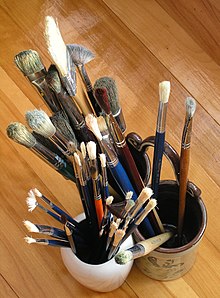Paintbrush

Paintbrushes
|
A paintbrush is a brush used to apply paint or sometimes ink. A paintbrush is usually made by clamping the bristles to a handle with a ferrule. They are available in various sizes, shapes, and materials. They may be subdivided into decorators' brushes used for painting and decorating and artists' brushes use for visual art.
The sizes of brushes used for painting and decorating.
Decorators' brush sizes are given in millimeters (mm) or inches (in), which refers to the width of the head. Common sizes are:
Bristles may be natural or synthetic. If the filaments are synthetic, they may be made of polyester, nylon or a blend of nylon and polyester. Filaments can be hollow or solid and can be or untapered. Brushes with tapered filaments give a smoother finish.
Synthetic filaments last longer than natural bristles. Natural bristles are preferred for oil-based paints and varnishes, while synthetic brushes are better for water-based paints as the bristles do not expand when wetted.
A decorator judges the quality of a brush based on several factors: filament retention, paint pickup, steadiness of paint release, brush marks, drag and precision painting. A chiseled brush permits the painter to cut into tighter corners and paint more precisely.
Brush handles may be made of wood or plastic while ferrules are metal (usually nickel-plated steel).
Short handled brushes are for watercolor or ink painting while the long handled brushes are for oil or acrylic paint.
The styles of brush tip seen most commonly are:
Some other styles of brush include:
Artists' brushes are usually given numbered sizes, although there is no exact standard for their physical dimensions.
From smallest to largest, the sizes are:
Sizes 000 to 20 are most common.
Types include:
Turpentine or thinners used in oil painting can destroy some types of synthetic brushes. However, innovations in synthetic bristle technology have produced solvent resistant synthetic bristles suitable for use in all media. Natural hair, squirrel, badger or sable are used by watercolorists due to their superior ability to absorb and hold water.
...
Wikipedia
